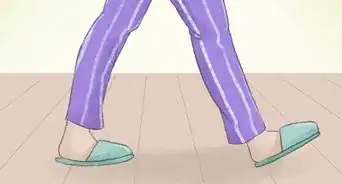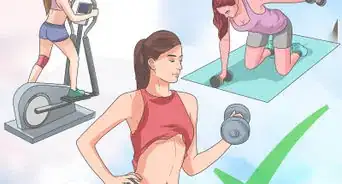This article was co-authored by Chris M. Matsko, MD. Dr. Chris M. Matsko is a retired physician based in Pittsburgh, Pennsylvania. With over 25 years of medical research experience, Dr. Matsko was awarded the Pittsburgh Cornell University Leadership Award for Excellence. He holds a BS in Nutritional Science from Cornell University and an MD from the Temple University School of Medicine in 2007. Dr. Matsko earned a Research Writing Certification from the American Medical Writers Association (AMWA) in 2016 and a Medical Writing & Editing Certification from the University of Chicago in 2017.
There are 17 references cited in this article, which can be found at the bottom of the page.
wikiHow marks an article as reader-approved once it receives enough positive feedback. In this case, 82% of readers who voted found the article helpful, earning it our reader-approved status.
This article has been viewed 270,700 times.
The core temperature of the average adult human is normally around 98.6 °F (37.0 °C), but may vary depending upon certain conditions. If you're partaking in physically exerting activities in a hot environment, or sometimes just exposed to a hot environment for a prolonged period of time, your body temperature could rise to dangerous levels. If your body temperature reaches 104 °F (40 °C), you could experience heatstroke.[1] Dropping your temperature too low can be equally dangerous, however, with only a three degree reduction in body temperature (95 °F (35 °C)) needed to induce hypothermia.[2] Lowering your core temperature for short periods of time can help you avoid heatstroke, improve sleep, or reduce a fever, but it's important to know how to do this safely.[3]
Steps
Using Medically-Verified Methods
-
1Drink cool fluids. Drinking plenty of cool fluids, up to 2 to 3 liters (0.5 to 0.8 US gal) at a time, is a good way to lower your core temperature quickly and safely.[4]
- Drinking adequate amounts of water can prevent dehydration, which is important in hot environments and during physically-demanding activities.[5]
- Sugary drinks and popsicles are not as good as pure water, because sugary drinks are not adequately absorbed by the body and can lead to further dehydration.
-
2Eat crushed ice. Studies suggest that ingesting crushed ice can be an effective way to quickly and easily cool the body. Crushed ice will also help keep the body hydrated.[6]Advertisement
-
3Take a cold shower or ice bath. Doctors generally agree that cooling the skin is the most effective method of lowering the body's temperature, especially when the person is at risk of heat stroke. Taking a cold shower or soaking in an ice bath can be particularly effective at cooling the skin quickly, particularly in high-humidity environments in which the body is no longer able to adequately sweat.[7]
- Allow cold water to run over the scalp, as this is the site of a confluence of blood vessels. Cooling the scalp can quickly cool the rest of the body.[8]
-
4Place ice packs on your body. Certain areas of the body emit more sweat to aid in cooling down your core temperature. These areas, called hot spots, include the neck, armpits, back, and groin. Positioning ice packs on these crucial areas can help cool you down and lower your core temperature.[9]
-
5Relax in an air conditioned environment. Experts suggest that air conditioning is one of the biggest factors in preventing heat stroke and heat-related deaths.[10]
- If you do not have an air conditioner in your home, try staying with a friend or relative during hot or humid spells, or contact your local health department to find an air-conditioned shelter near you.[11]
-
6Sit in front of a fan. Whenever a liquid, in this case sweat, evaporates off the body, the hottest molecules of liquid evaporate the quickest. Since the air temperature is generally cooler than your skin's temperature, sitting in the direct path of a fan’s air while sweating can help drop your body's temperature.[12]
- If you are not sweating enough to cool your body down due to age or health problems, you can try misting your body with cool water while sitting in front of a fan. Just fill up a spray bottle from the faucet and mist your body as needed while the fan blows in front of you.[13]
-
7Take fever-reducing medications. Antipyretic (temperature reducing) medications are a safe and easy way to lower your body temperature in case of a fever. These medications work by inhibiting your body's production of cyclooxygenase and lowering your body's levels of prostaglandin E2. Without the help of an antipyretic, these substances cause the cells in the hypothalamus (the part of the brain that regulates temperature) to fire at a rapid rate, increasing the body’s temperature.[14]
- Examples of these medications include acetaminophen, aspirin, and nonsteroidal anti-inflammatory drugs (NSAIDs) such as ibuprofen and naproxen.[15]
- Aspirin is not recommended for children and teenagers suffering from viral illnesses (including the flu or chickenpox), as it can lead to the development of Reye's Syndrome, a rare but potentially fatal disease that damages the brain and liver.[16]
- The dosage of these medications varies depending on your age. Check the recommended dosage on the label and do not exceed the recommended daily dosage. Consult with your physician for proper dosages and recommendations on over-the-counter medications.
Making Lifestyle Changes
-
1Avoid extreme or strenuous activities. If you engage in strenuous and vigorous activities, especially during hot or humid weather, your body will heat up due to the expense of energy and physical exertion.[17]
- Try exercising in less physically demanding ways, such as walking or cycling. If you insist on maintaining your usual level of workout intensity, be sure to take frequent breaks and avoid over-exerting yourself.[18]
- Swimming can also be a good way to naturally lower your body temperature while exercising, because you will be submerged in cool water.[19]
-
2Wear light colored and loose-fitting clothes to reduce heat retention. It's important that your clothing allows air to circulate over your skin to cool you off, but you also want to be sure that your skin is covered to prevent additional sun exposure.
- Light-colored clothing reflects the sun's light rather than absorbing it, thereby lowering the level of heat in the body. Avoid wearing dark colored and thick clothes, as these clothes are known to attract and trap heat.[20]
-
3Avoid eating spicy and fatty foods. Hot and spicy foods can increase your metabolism, acting like stimulants to elevate your body temperature.[21]
- The compound found in chili peppers, capsaicin, naturally raises your body's temperature.[22]
- Food with a high fat content can lead to more heat being trapped in the body by increased levels of fat stored in the cells. This is because fat is responsible for storing heat in the body and making the body warmer.[23]
References
- ↑ http://www.mayoclinic.org/diseases-conditions/heat-stroke/basics/definition/con-20032814
- ↑ http://www.healthline.com/health/thermoregulation#Overview1
- ↑ https://www.hopkinsmedicine.org/health/conditions-and-diseases/exerciserelated-heat-exhaustion
- ↑ https://www.mayoclinic.org/diseases-conditions/heat-stroke/diagnosis-treatment/drc-20353587
- ↑ http://www.heart.org/HEARTORG/GettingHealthy/PhysicalActivity/FitnessBasics/Staying-Hydrated---Staying-Healthy_UCM_441180_Article.jsp
- ↑ http://jmvh.org/article/crushed-ice-ingestion-a-practical-strategy-for-lowering-core-body-temperature/
- ↑ http://www.nytimes.com/1987/08/21/arts/how-to-lower-body-temperature.html
- ↑ http://www.nytimes.com/1987/08/21/arts/how-to-lower-body-temperature.html
- ↑ http://www.mayoclinic.org/diseases-conditions/heat-stroke/basics/treatment/con-20032814
- ↑ https://www.cdc.gov/nceh/features/extremeheat/index.html
- ↑ https://www.cdc.gov/nceh/features/extremeheat/index.html
- ↑ http://www.nytimes.com/1987/08/21/arts/how-to-lower-body-temperature.html
- ↑ http://www.mayoclinic.org/diseases-conditions/heat-stroke/basics/treatment/con-20032814
- ↑ http://www.ncbi.nlm.nih.gov/pubmed/11566461
- ↑ http://www.medicinenet.com/analgesics_antipyretics/page3.htm#different
- ↑ http://www.mayoclinic.org/diseases-conditions/reyes-syndrome/basics/definition/con-20020083
- ↑ http://www.mayoclinic.org/healthy-lifestyle/fitness/in-depth/exercise/art-20048167
- ↑ http://www.mayoclinic.org/healthy-lifestyle/fitness/in-depth/exercise/art-20048167?pg=2
- ↑ http://www.mayoclinic.org/healthy-lifestyle/fitness/in-depth/exercise/art-20048167?pg=2
- ↑ http://www.npr.org/2012/07/25/157302810/summer-science-clothes-keep-you-cool-more-or-less
- ↑ http://www.nytimes.com/1983/09/21/garden/eating-spicy-food-what-are-the-effects.html
- ↑ http://www.nytimes.com/1983/09/21/garden/eating-spicy-food-what-are-the-effects.html
- ↑ http://healthland.time.com/2013/06/15/surprising-foods-that-toy-with-body-temperature/
About This Article
You can drop your core temperature easily by drinking cool liquids, eating crushed ice, or taking a cold shower. When taking a cold shower, make sure water runs over your scalp because there are many blood vessels there that will quickly cool the rest of your body. After your shower, sit in front of a fan or in an air conditioned room to stay cool, and wear light colored and loose-fitting clothing to trap less heat on you. If you are dealing with a fever, you can also use fever-reducing drugs like aspirin. To learn more from our Physician co-author, like what types of food to avoid if you want to lower your body temperature, keep reading!






































































Medical Disclaimer
The content of this article is not intended to be a substitute for professional medical advice, examination, diagnosis, or treatment. You should always contact your doctor or other qualified healthcare professional before starting, changing, or stopping any kind of health treatment.
Read More...